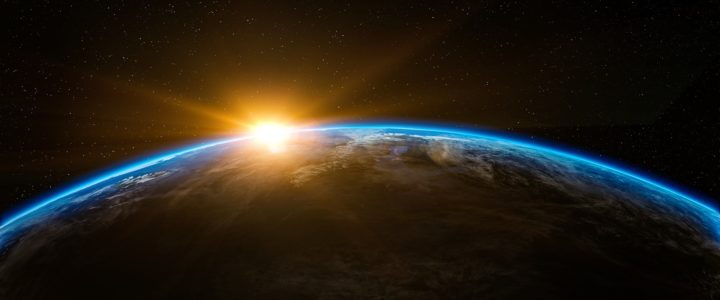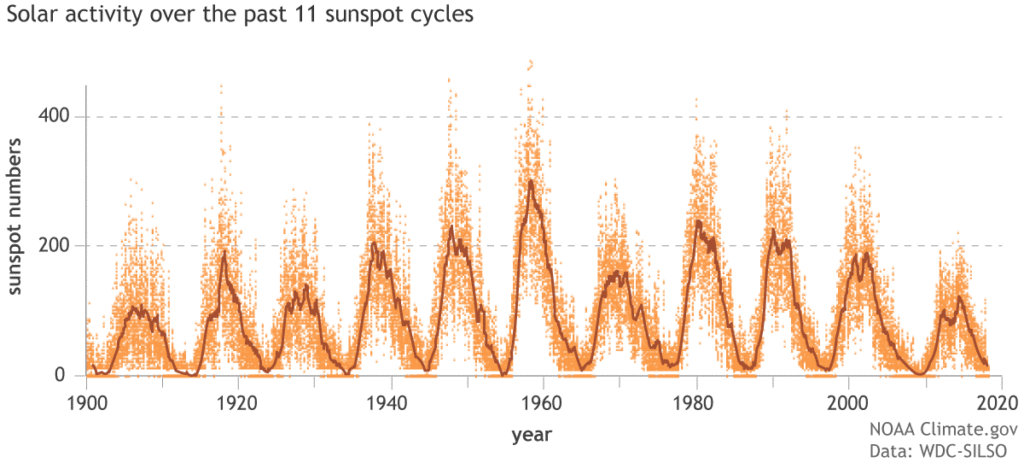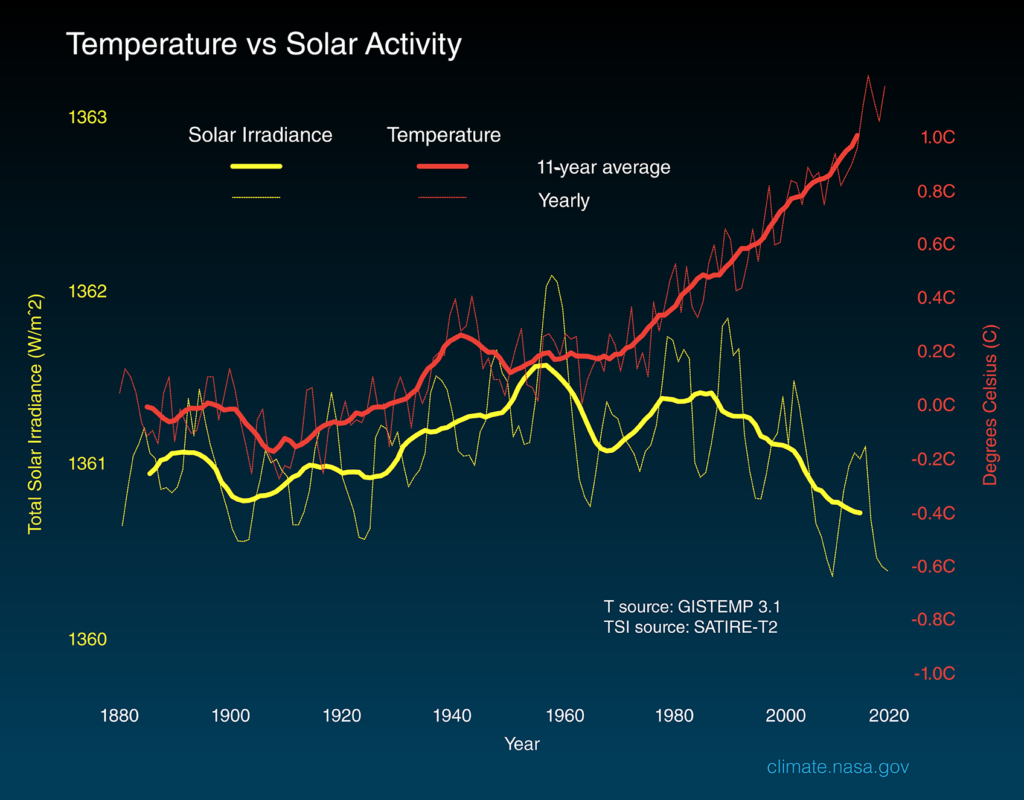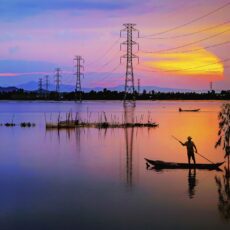
Whether it’s through a conversation with a climate change denier (or now a more accurate description is a climate delayer and distractor), you’ve likely tried to answer questions about the Earth’s natural climate cycles. Maybe these are questions you’ve just asked yourself at 2am in a somewhat misguided attempt to quell the noise of climate anxiety…no? Just me?
The Earth and the Universe in which it is located are wonderous things. Complex, intricate, intertwined, fragile and robust all at once, and incredibly beautiful. We’ve explored some of the interconnectedness with pieces on the Planetary Boundaries and biodiversity. The Earth’s climate system is no exception. There are 5 components to the climate system, all interacting with each other: the atmosphere, hydrosphere (oceans, rivers, lakes etc), cryosphere (ice and snow), lithosphere (land) and biosphere (marine and terrestrial plants and animals).

The global climate system is predominantly driven by the energy from the sun. About 30% of this solar radiation is bounced right back to space from the atmosphere, while the remaining 70% reaches the Earth’s surface – the majority absorbed but a small percentage then also being reflected back to space. The sun’s brightness isn’t always stable. Over an 11 year cycle it dims and brightens. Radiation levels fluctuate and the activity observed on the sun’s surface, like occurrence of sunspots and solar flares, changes. Given all this information, it’s not hard to see the sense in an argument for global warming being caused by the sun, plain and simple. But that has most definitely been disproved as a hypothesis. December 2019 saw the end of Solar Cycle 24, and during most of the year the sunspot activity was very low. However, 2019 was the third warmest year in 140 years of records (2020 is the second on this list). So these peaks and troughs in solar activity cannot explain the consistently rising temperatures, and in particular, the fact that the temperatures are getting higher in the lower parts of our atmosphere only. If solar activity were to blame for increasing global temperatures we would see an even distribution of this heat at all altitudes.

The Milankovitch Cycles are another pattern of activity which can impact global climate. These include three types of Earth’s orbital movement, and the effect they have on how much solar radiation reaches the Earth’s atmosphere. These cyclical orbital movements can cause variations of up to 25% of solar radiation at the Earth’s middle latitudes. The cycles include the shape of the Earth’s orbit, called eccentricity; the angle Earth’s axis is tilted with respect to the orbital plane, known as obliquity; and the direction Earth’s axis of rotation is pointed, called precession.
Eccentricity
The Earth’s orbit around the sun doesn’t write a perfect circle in space. Over time the gravitational pull from Jupiter and Saturn send Earth into a slightly elliptical orbit. This means that at some times we’re closer to the sun than at other times – when we’re at our most elliptical, about 23% more solar radiation reaches Earth in January than it does in July. These cycles are approximately 100,000 years long.
Obliquity
This is the reason we have seasons. The greater the tilt, the more extreme the seasons, because more of the hemisphere is either facing to or away from the sun. We are at about halfway between minimum and maximum tilts, gradually heading to the minimum – which we’ll reach in about 9,800 years from now. The full cycle is approximately 41,000 years.
Precession
This is the little wobble of Earth as it spins on its axis. Think of it like a spinning top being ever so slightly off center. It’s the gravitational pull of the sun and moon which cause this to happen, because it makes the Earth bulge a little at the equator. The trend of the wobble’s direction, or axial precession, is measured by looking at the position of the axis in relation to the fixed position of the stars. This cycle spans about 25,771 years. The Earth also wobbles in its elliptical orbit, again due to the pull of Saturn and Jupiter. This is apsidal precession, and the cycle is about 112,000 years long. Both of these cycles affect the severity of seasonal variations and season length. The combined effect of both is a precession cycle of about 23,000 years.
Although these are super interesting and do impact seasons, they are not an answer to the continual and rapid rise in global average temperatures.

During normal conditions in the Pacific Ocean trade winds (the prevailing easterly wind which blows along the equator) take warm water from South America to Asia. This starts a process called upwelling, where cooler water is cycled up from the depths of the ocean to nearer the surface. These conditions, however, are changed by El Niño and La Niña, which are two opposing climate patterns. Although they occur in the Pacific Ocean they impact the global climate. They each last between 9 and 12 months usually, though it’s not uncommon for La Niña to last several years. They will most often occur every 2-7 years, but without a regular schedule. El Niño tends to come around more often than La Niña. The phenomena of these systems is called the El Niño-Southern Oscillation (ENSO) cycle. Both will see changes in ocean temperatures, currents, jet streams, storms like cyclones and even marine life.
El Niño
El Niño sees the trade winds weaken, so warm water is pushed back toward the west coast of South America. The jet stream is shifted south from its neutral position, causing warmer, drier weather in North America and Canada, but wetter weather in the US Gulf Coast. For the Southern Hemisphere, El Niño usually means warmer temperatures, reduced rainfall, reduced cyclone risk, increased fire danger. Nine of the 10 driest winter-spring periods on record have been El Niño years, including the devastating droughts of 1982, 1994, 2002, 2006 and 2015.
La Niña
The trade winds of La Niña are stronger than usual, so warm waters are pushed toward Asia and the colder waters of the Pacific cause the polar jet stream to shift northward. The southern US could experience drought due to less rainfall, while the Pacific Northwest and Canada could see flooding. The Southern Hemisphere will have much more rain in the winter-spring than usual, and cooler temperatures lasting even through the summer.
Mother Earth is far too sophisticated to think that mere mortals can destroy her. But damage her? And see many precious plants and animals pay the ultimate price of extinction? Yep – that, we’re capable of. After reading a little more about some of the normal cycles of Earth (some spanning tens of thousands of years!), it is hoped you’re better positioned to debate the climate delayers/distracters. The scientific evidence is clear: no natural cycle or process or pattern can explain the rapid and continual rise of global average temperatures; the subsequent sea level rise; the Glacial melting and slow refreezing; the permafrost melting; the increasing frequency and severity of storms; or the ocean acidification. No. That is all us. Humans, indeed, are powerful. And it with this mighty force that we have made our presence felt, by every other living thing on the planet. So we must start to use our power for good, to try to return balance to the atmosphere and hydrosphere and biosphere – before it is too late.




